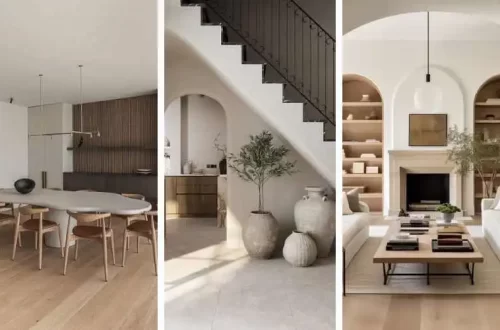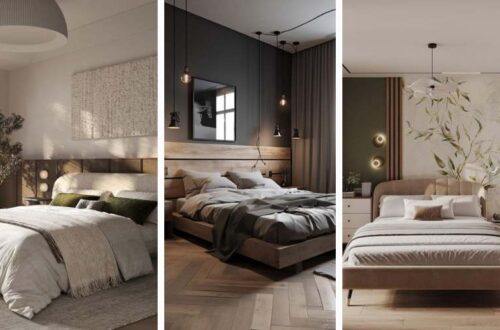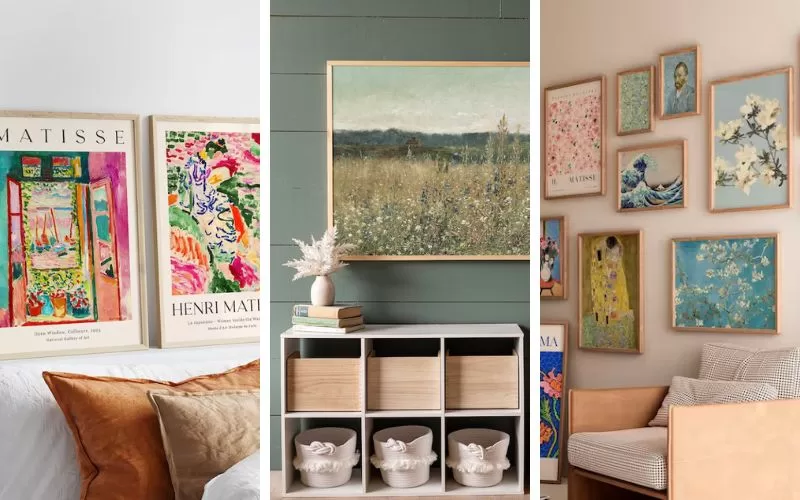
Hanging Wall Art – A Comprehensive Guide
Share this
Hanging wall art shouldn’t be complicated and in this article, we will explore how to decorate our walls with art and pictures.
I will share the basics for selecting the best pieces that truly enhance your home.
We will also discover plenty of ideas and inspiration on how and where to place them to give your house that magazine-worthy look with a touch of spectacular personality.
As a bonus, I will share five things I would avoid when decorating with pictures.
Choose artwork that matches your style
First, you should have a clear idea of the decoration style for your home.
This is crucial because artwork not only contributes to the composition but also adds character and personality to the space.
Reflect on your personal preferences in terms of colors, themes, styles, and the emotions that attract you.
It’s also important to familiarize yourself with different artistic styles like impressionism, surrealism, expressionism, abstract art, minimalism, or any other style that appeals to you.
For instance, if you prefer a classic style, oil paintings or black and white photographs can be a perfect fit.
If you lean towards a modern or contemporary style, abstract or expressive art, or even minimalism, can work wonderfully.
On the other hand, if you’re bohemian or eclectic, ethnic art, vintage illustrations, or surrealistic artwork may be more suitable for your taste.
Notice how each artwork example expresses an authentic personality and resonates within the space.
The point is to identify the style of your home and find coherent pieces that harmonize with both the space and your personality.
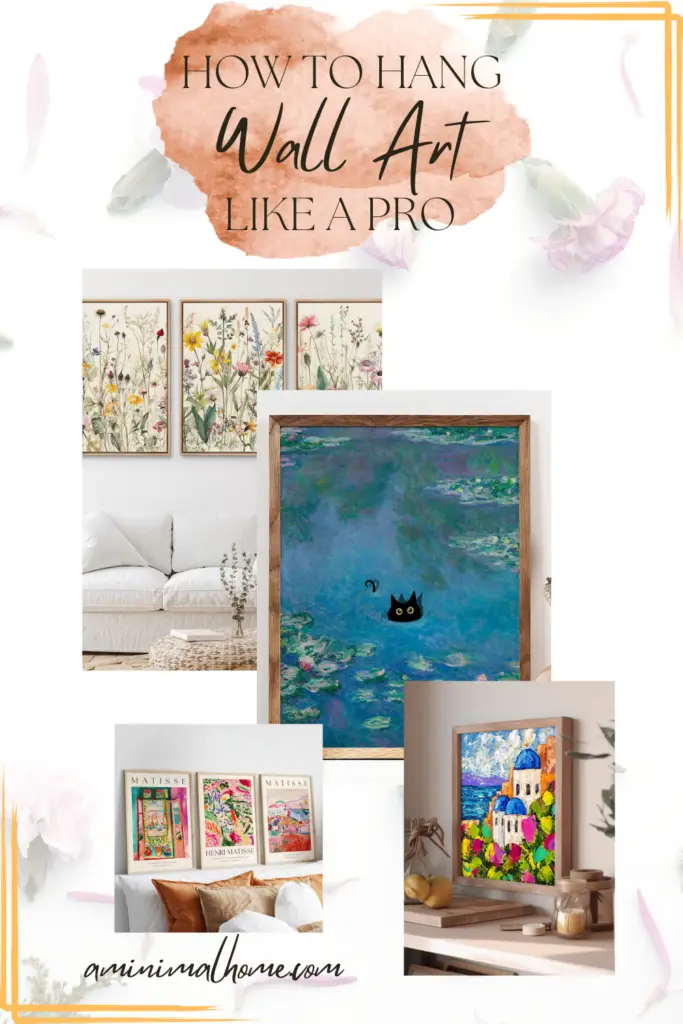
Best artwork colors
Let’s talk about colors now.
The crucial thing here is to consider your existing palette.
Take a look at the dominant colors in your space, like the tones of the walls, furniture, and decorative elements.
When it comes to combining colors, you have several options, and it doesn’t necessarily have to be everything in the same color.
Dare to mix it up!
You can use the famous color wheel as a guide.
One option is to go for a complementary scheme, where you choose colors that are opposite each other on the color wheel.
This creates a vibrant and attractive contrast.
For example, if the walls are a soft blue tone, you can consider hanging wall art with accents of orange or yellow.
This scheme works great when you want the artwork to stand out as focal points in the room.
If you prefer a more harmonious appearance, choose artwork that features similar tones to those in the room.
For example, if your color palette consists of warm earthy tones, select artwork that blends smoothly with the surroundings.
To achieve that seamless blend between art and space, you can also go for monochromatic and analogous combinations.
Lastly, consider the mood you want to convey in your space.
Warm colors like reds and oranges can evoke a sense of energy, making them perfect for the kitchen or social areas.
On the other hand, cool tones like blues and greens can create a more tranquil and relaxing atmosphere, ideal for bedrooms or areas of rest and relaxation.
It’s important to highlight that artwork is excellent for adding color to a space with neutral tones.
In fact, a tip to start playing with color is to choose accent shades inspired by that impressive and focal piece of art in your space.
Pick an artwork theme
One important point to consider is the theme of the artwork.
The theme refers to the concept, story, or message that the artist wants to convey through their creation.
Choosing the right theme is crucial, as it defines the focus and meaning of the artwork in your space and mood.
Now, let’s talk from my point of view and what I find pleasant for a residential setting.
I would avoid hanging wall art with aggressive themes, whether literal or abstract.
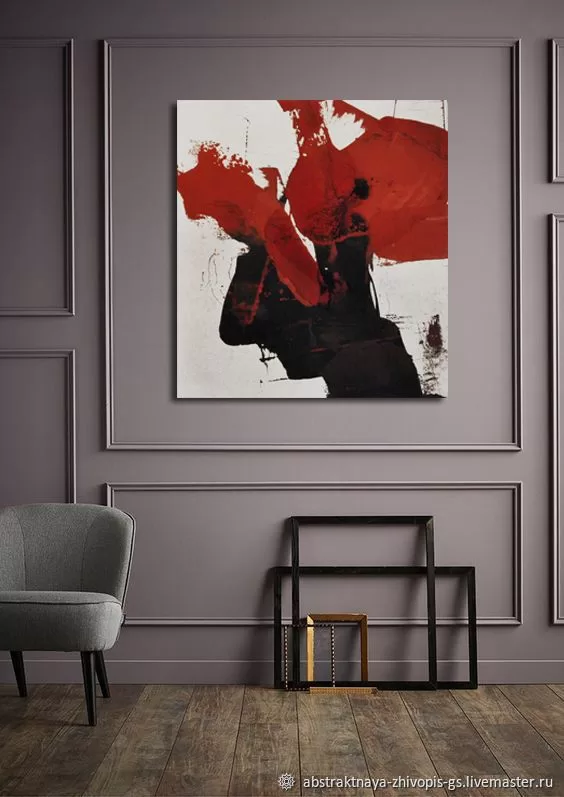
Take a look at this painting. Even though it doesn’t have a literal image, it feels aggressive, right?
The splashing red paint give the impression of a crime scene.
Now, we’re not criticizing the artwork itself; it may be perfect for a museum or someone who appreciates it.
But if you’re looking for something pleasant for your home, there are similar paintings that can work better, with subtler movements and less aggression.
I understand that every piece of art expresses the artist’s feelings beautifully.
However, I believe that emotions and the essence of things have a great influence on us and our environment.
Therefore, seeing negative things constantly while resting or spending time with family, I don’t think those artworks have a positive impact.
Choosing a theme that fills you is a starting point.
Reflect on your interests and passions.
Is there a particular theme that inspires you? It could be nature, music, love, history.
Let your home represent what uplifts and brings joy to you.
Best wall art size
Let’s talk about something really important: the proportion and scale of artwork in our homes.
In my opinion, this is one of the biggest issues I notice when it comes to art placement.
Often, I see huge walls adorned with tiny pieces of art, or large walls with just a few small spaced-out frames.
It just doesn’t look right. Sometimes, it’s better not to hang anything at all.
So how can we determine the right proportion for our space?
First, it’s important for the art to harmonize and relate to the furniture around it.
Let’s explore some typical examples to understand this concept of proportion.
The art should almost cover the width of the headboard of a bed.
If it’s too small, it looks out of place. If it’s too big, it overpowers the bed. You see what I mean?
There are no specific numbers here; it’s a matter of instinct and finding the right balance.
Another guideline I love is choosing artwork that is about two-thirds the width of the furniture below it.
This helps maintain a harmonious proportion.
It should also span almost the entire width of a sideboard.
If it’s too small, it gets lost, and if it’s too big, it dominates the sideboard.
Shop entryway wall art! (click photo)

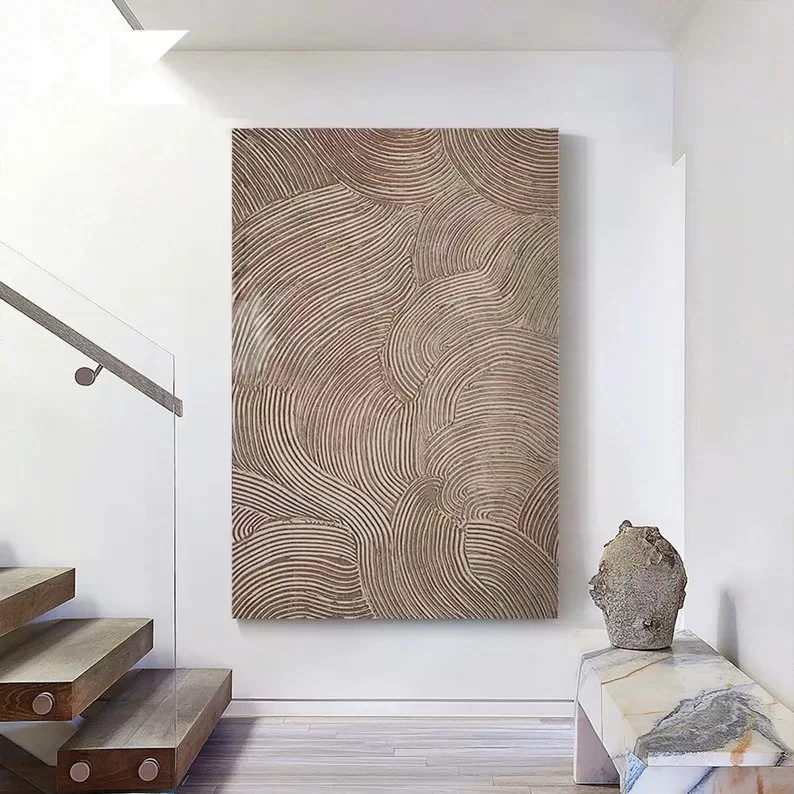
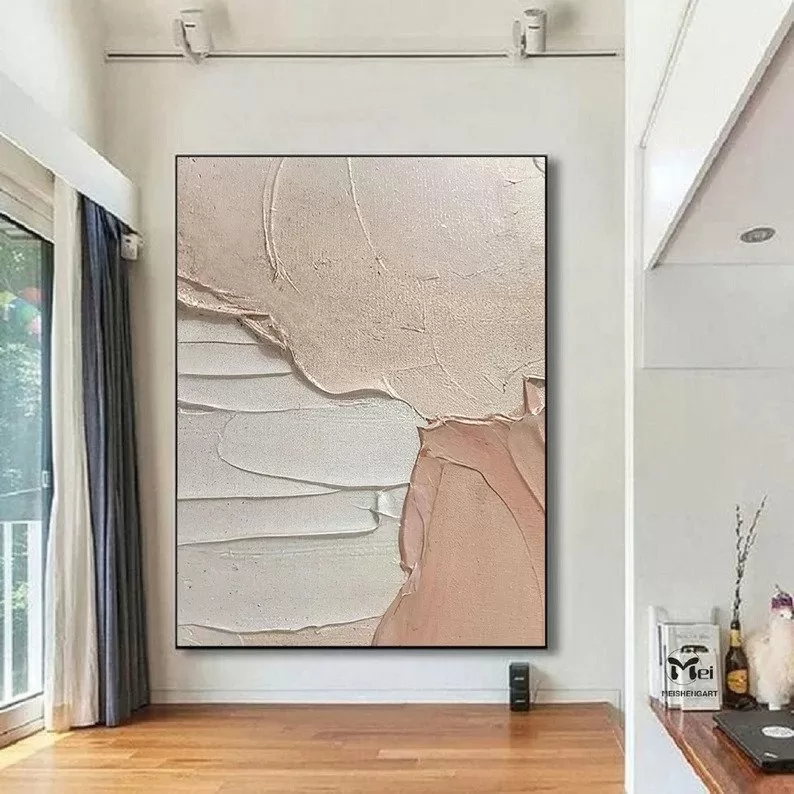
Entryway artwork ideas
Let’s dive into some specific ideas on where and how to use frames in different areas of your home.
Alright, let’s start with the first impression of your home – the entryway.
This space is great for a standout piece.
If you’re not into mirrors, opt for a large and eye-catching frame as a focal point in your entryway.
It could be a colorful artwork, a striking photograph, or something that speaks to you.
Another idea is to display the frames on a shelf or table in the entryway instead of directly hanging them on the wall.
This even allows you to easily change your frames and add additional decorative items like books or vases, giving you the freedom to switch up the look of the space often.
It’s perfect for those who love versatility, and it adds a beautiful and modern touch.
Another idea that brings a free and fluid style is creating a gallery of frames.
For example, you can use frames representing landscapes, botanical elements, or portraits and play around with different sizes and shapes to add dynamism to your composition.
Since the entryway is all about making a statement, don’t forget to complement the artwork with good lighting.
For instance, having two sconces on each side of the piece would be great to create an attractive and relaxing ambiance.
If you find it challenging to deal with electrical installations but love this idea, let me tell you that there are wall lamps with rechargeable bulbs available.
They don’t require any electrical wiring and can work beautifully to add that special touch.
Trust me, I personally love these lamps. You can even find them on Etsy without any hassle.
Shop living room wall art! (click photo)



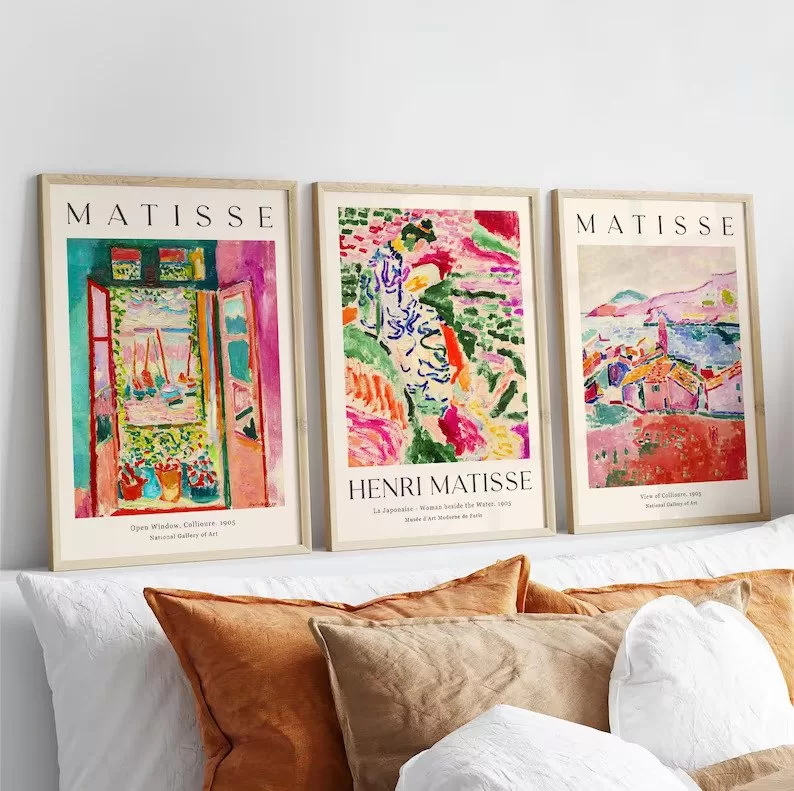
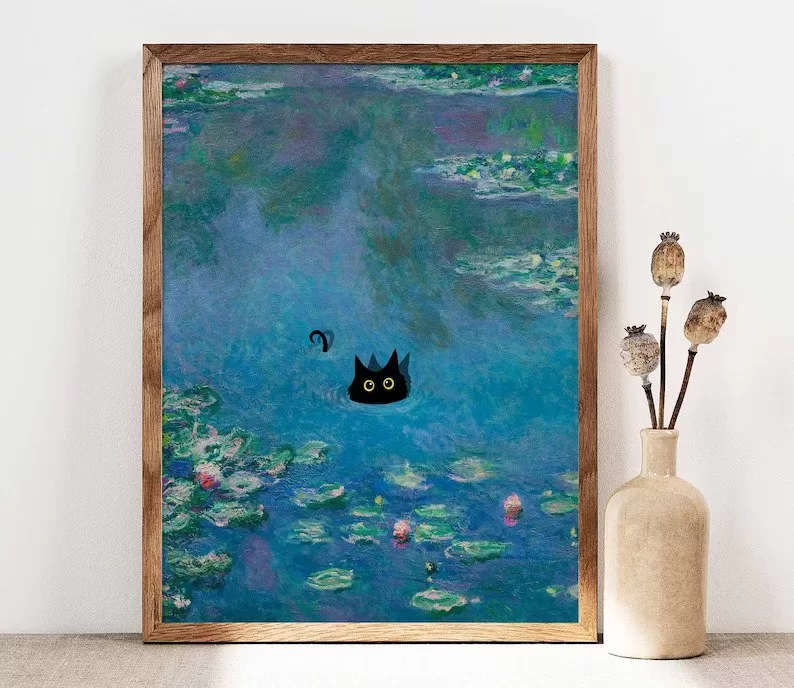

Hanging wall art in the living room
If you’re looking to add personality and strength to your artwork, there are plenty of options!
For instance, placing them above a fireplace can create a spectacular effect by emphasizing the vertical axis of the room.
To make your space more impressive, consider hanging a beautiful painting above the sofa.
If you have a window behind the sofa and empty walls on the sides, hanging artwork in those areas can create a composition that adds height and elegance to your living room.
Additionally, you can use shelves or display shelves to showcase artwork, either by leaning the pieces against them or hanging them on the wall.
It’s important to complement your artwork with other decorative objects like plants, vases, and books to add personality.
This combination will bring visual interest and depth to your living room!
Shop dining room wall art! (click photo)

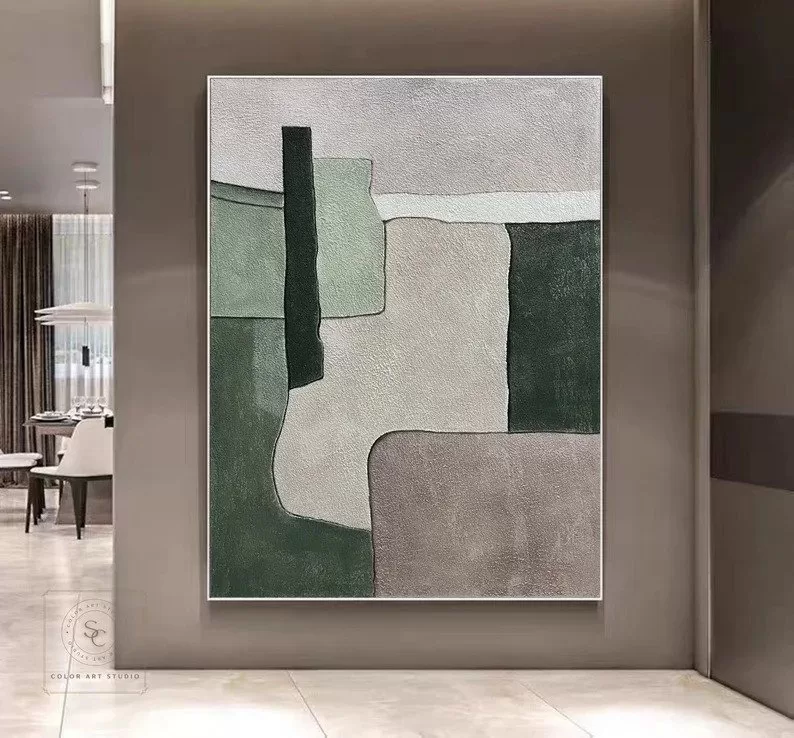
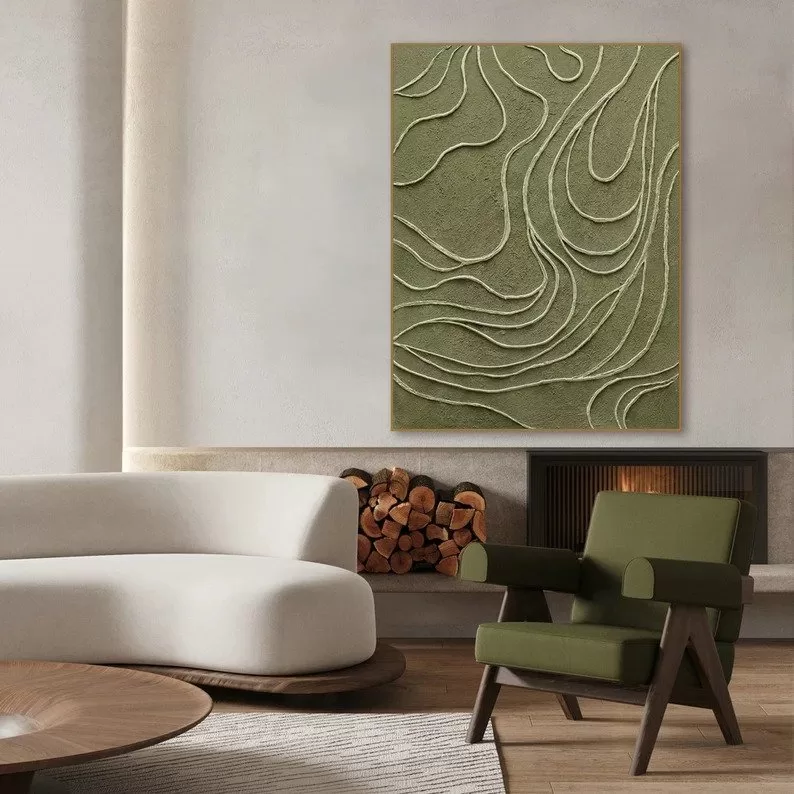
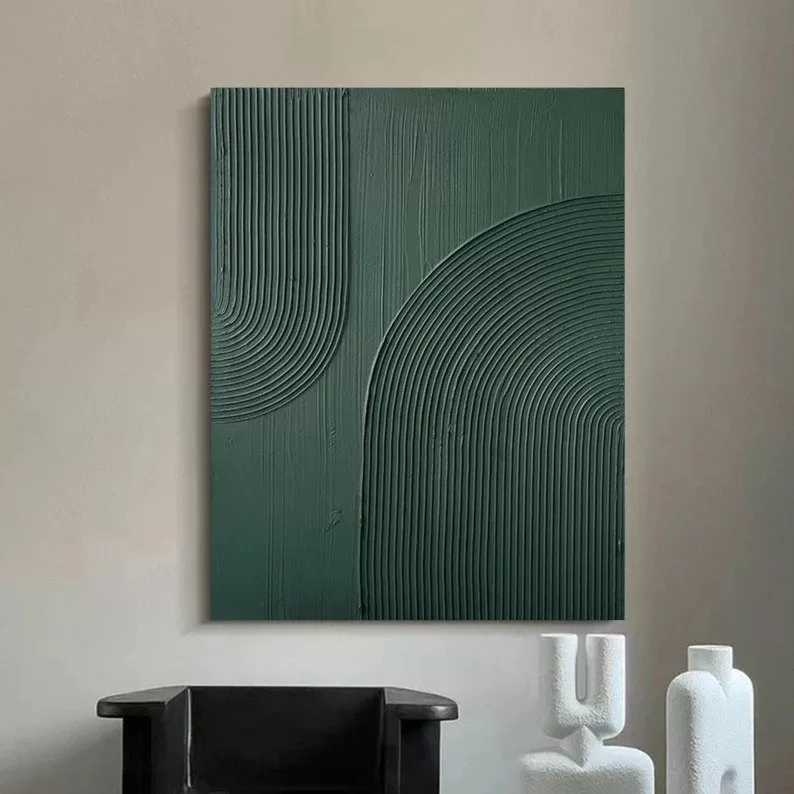
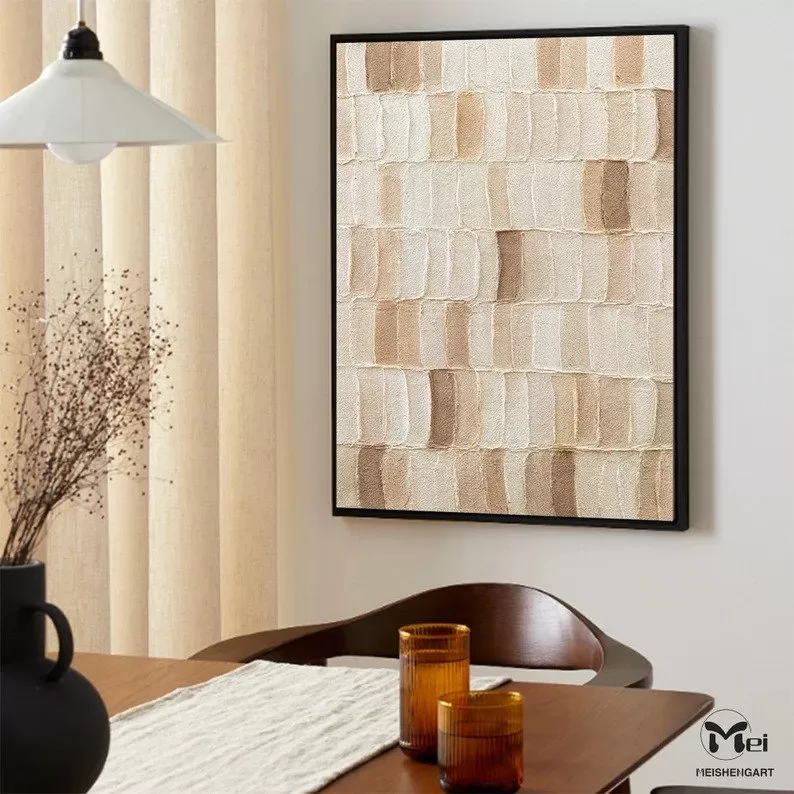
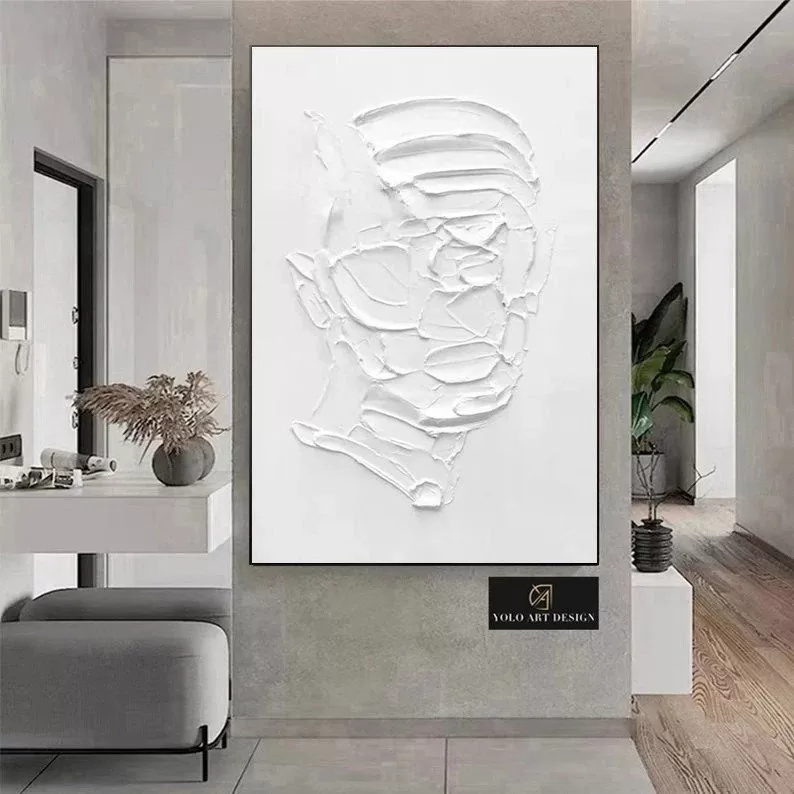
Dining room artwork ideas
Creating a stunning focal point in your dining area is key.
With so many cool ideas to choose from, it all depends on the space you have.
You can transform a wall into an accent wall using a large piece of art.
To add more energy and vibrancy, opt for something dynamic and colorful.
Check out this impressive example where the artwork perfectly complements the tones of the chairs – they belong together in a beautiful composition, don’t you think?
Here’s a design tip: if you go for a spectacular painting in this area, consider hanging a simple pendant lamp above the table.
This way, you won’t overshadow the artwork or block the view.
A hanging lamp in line with your style, with glass globes, can work wonders.
It allows you to appreciate that stunning piece of art.
Take a look at this example – notice how the height of the lamp is carefully considered.
Its light and minimalist aesthetic doesn’t compete with the artwork in the background, creating a balanced, elegant, and beautiful composition.
Another option is to create a gallery wall with multiple paintings.
You can go for a symmetrical composition if you prefer a more formal style, or something free-flowing and organic if your taste is more modern.
Hanging wall art in the hallway
Transitional spaces are highly sought after when it comes to artwork.
We absolutely love these hallways for hanging pieces because they provide the perfect canvas for visually stunning compositions.
Along the length of the hallway, you can create a captivating visual line by placing a series of paintings either horizontally or vertically.
If you have a spacious background wall, consider showcasing an impressive artwork to create a focal point and add depth to the space.
Hallways often connect social areas like the living room, dining area, and kitchen with more intimate spaces like bedrooms.
That’s why it’s a great idea to create a gallery of family photographs capturing intimate moments.
Opt for frames of the same color and style to maintain visual cohesion throughout the entire journey.
Shop bedroom wall art! (click photo)
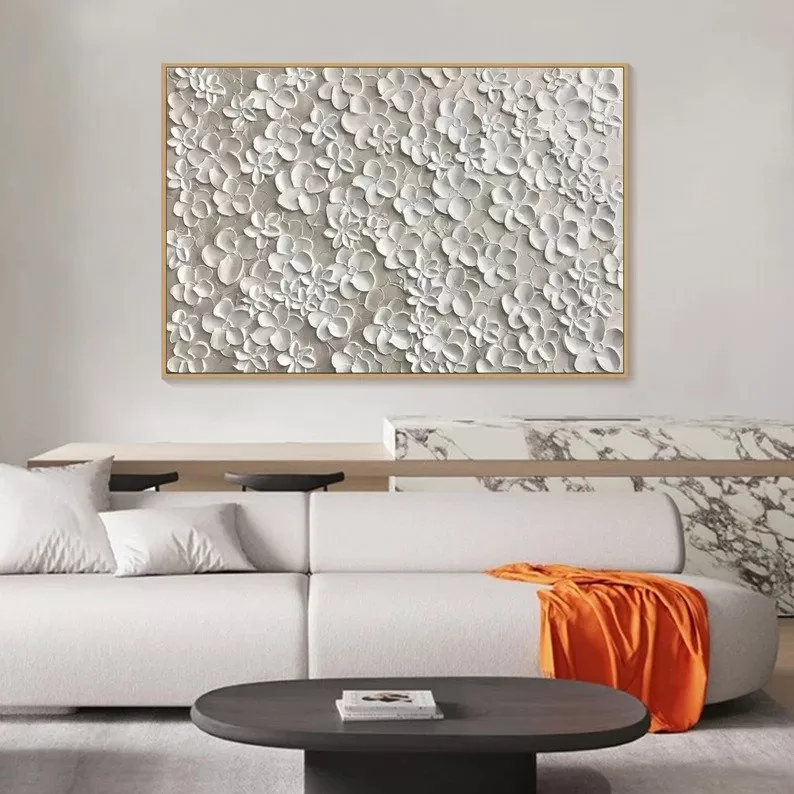
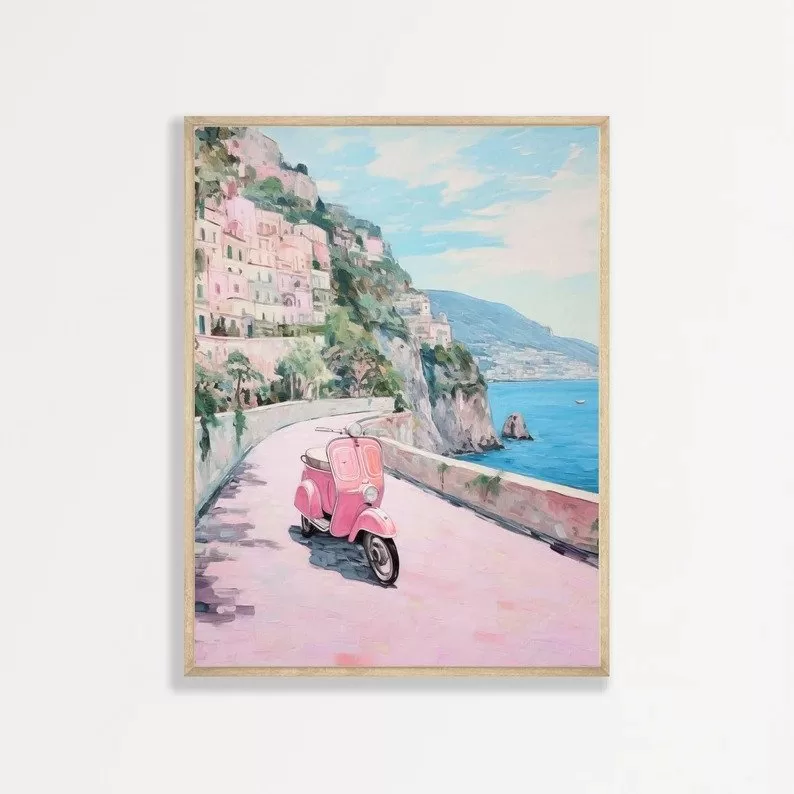
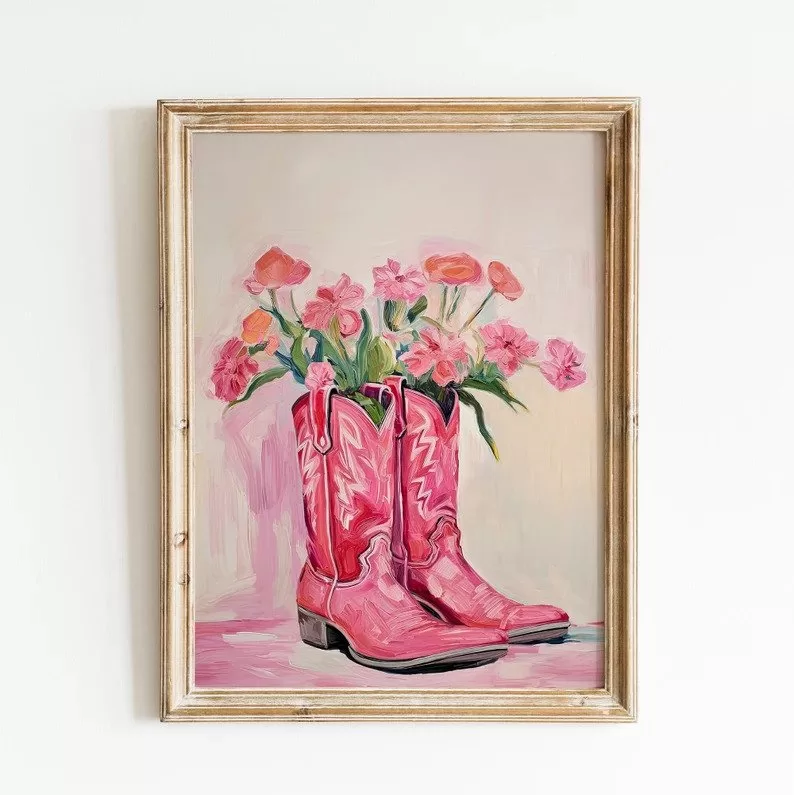

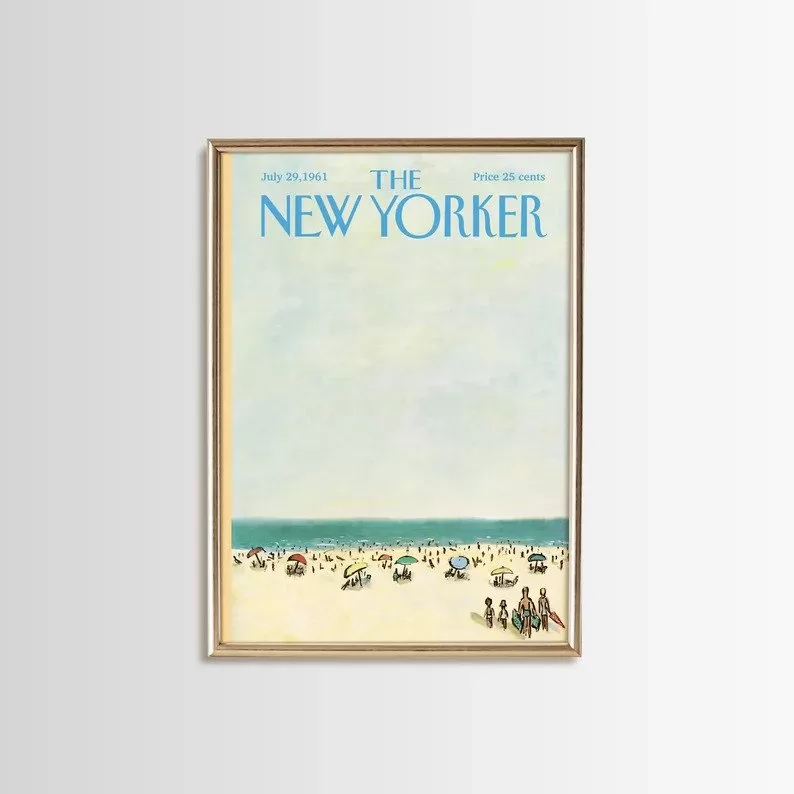
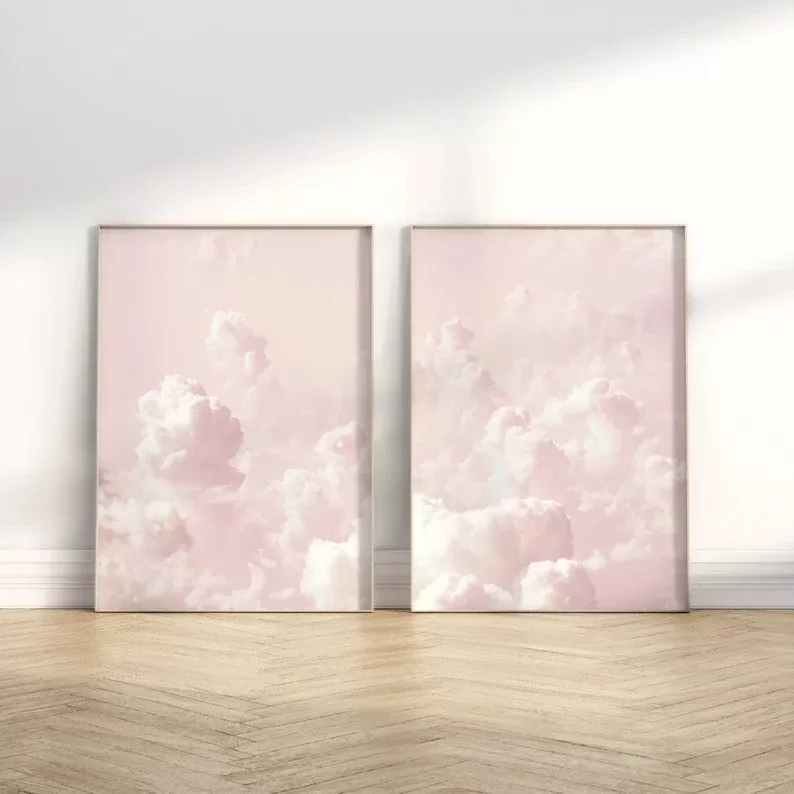
Bedroom artwork ideas
There are several areas to showcase our artwork, but undoubtedly the most impressive is a large painting or a composition of multiple paintings above the bed.
I recommend choosing an art piece that exudes calmness and serenity within your style.
If you have a window by the headboard, you can use adjacent paintings or opt for a composition of paintings of various sizes and shapes on the side wall, extending vertically or horizontally based on the available space.
Kitchen artwork ideas
Kitchens have their own charm, you know!
You can go for a culinary theme, abstract art, vintage vibes, or keep it minimalistic.
Depending on your kitchen’s style and colors, you can showcase them on open shelves along with other decorative elements like plants, spices, or kitchen utensils.
Another idea is to adorn an empty wall near the island or food preparation area.
You can even place them on a countertop for added beauty.
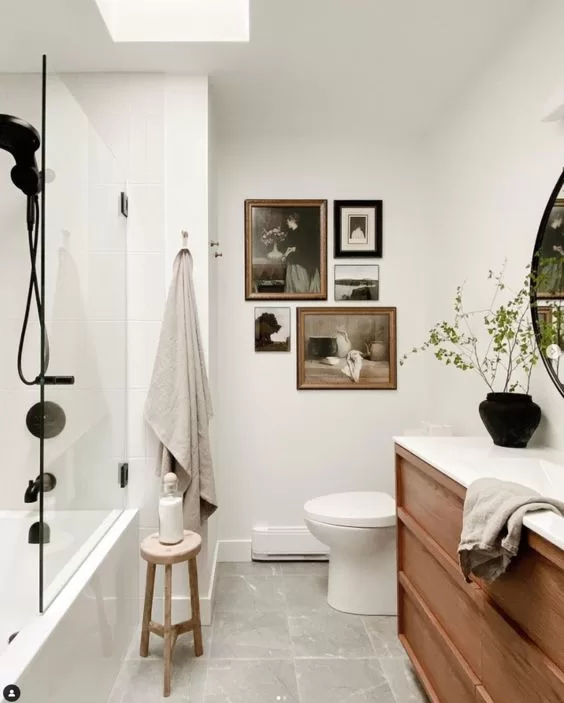
Bathroom artwork ideas
Look at how beautiful bathrooms can be! It seems amazing to me, I even love it because these areas are now part of our home decor.
They have transformed from something functional to a pleasant space that we enjoy.
I especially love this idea for guest visits, where you go from the living room to the bathroom in seconds.
The transition doesn’t feel abrupt; everything feels well-decorated and harmonious.
Things to avoid when it comes to wall art
I’ll share some things that I wouldn’t do when it comes to choosing and decorating with paintings.
Avoid generic art
One thing I wouldn’t do is invest in generic and widely reproduced paintings that everyone has at home.
Don’t get me wrong, I’m not against buying ready-made paintings or even screen prints.
I love screen prints! But I would choose ones made by artists or paintings from my favorite artists.
For example, those Van Gogh paintings. I love them!
Of course, I would buy those paintings, but I would never buy something that holds no value for me.
I would never buy a painting that doesn’t fill my soul or doesn’t have a concept or meaning to it.
I mean, buying a painting just because it’s popular and everyone has it? No way!
Hanging wall art properly
First, grab a piece of paper and put your artwork on top of it.
Then, trace the outline of the frame with a pencil.
Remember, avoid using markers or pens to prevent any accidental stains on the frame.
Once done, cut along the traced lines.
Take a measuring tape and find where your artwork will make contact with the nail or hook.
Mark this spot on the paper.
Next, use some tape to stick the paper on the wall, at the height and position you think will look best.
This will give you a visual preview of how your artwork will fit in the space and interact with the background wall.
If you’re not completely satisfied with the placement, feel free to adjust the height, try different angles, and move the paper around until it looks spectacular.
Take your time and view it from various perspectives.
Once you’re happy with the result, it’s time to transfer the mark to the wall.
Simply make the same marking on the wall where you had it on the paper.
You now have the perfect spot for hanging wall art. No more misplaced artworks, ever!
Don’t overcrowd your walls
Hanging wall art on every wall used to be a common practice decades ago.
It was all about filling every empty space with paintings.
However, I don’t agree with this approach when it comes to composition and the idea of fullness and emptiness.
If we put artwork on every single wall, from top to bottom, nothing will catch our attention because it becomes oversaturated.
Nothing stands out. Personally, I prefer to identify specific key areas to create focal points and depth.
I place my pieces there and leave the surrounding surfaces silent, allowing our attention and vision to focus on those specific points.
There’s nothing wrong with leaving some walls empty.

Hanging wall art ideal height
When hanging pictures, it’s important to find the right balance.
Avoid placing them too high or too low; let’s aim for the sweet spot.
Have you ever seen those pictures almost reaching the ceiling?
Who would actually admire them up there?
In general, it’s recommended to position the center of the picture at eye level, around 59 inches (150 cms) from the floor.
However, keep in mind the height of the people using the room.
If you’re hanging a composition of multiple pictures, make sure the average height aligns with the eyes and then arrange the rest accordingly.
This will create an appealing visual focal point and ensure that the pictures harmoniously come together.
Be careful with humid spaces
I wouldn’t hang pictures on walls with humidity issues.
Moisture can damage both the artwork and the walls.
Make sure the walls are in good condition before hanging any valuable or important pieces. This is a serious matter.
In just a few months, your art could get moldy, warped, and extensively worn. So, it’s best to avoid this.
If you want to continue learning about design and how to make your home a spectacular space, I recommend subscribing to my blog.
Also don’t forget to read all these interior design articles for your home.
Do you have any tip for hanging wall art? Share it in the comments below.
This post might contain affiliate link(s). As an affiliate, I may earn a small advertising /referral fee if you purchase through my link, without any extra cost to you, and it helps keep this little blog afloat. Thanks so much for your support!



